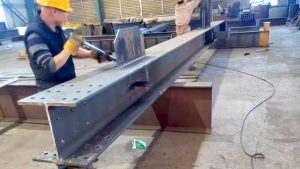Hot-rolled H-section Steel Column
A hot-rolled H-section steel column is a vertical structural member made from steel that has been shaped into an “H” cross-section through the hot rolling process.
Hot-rolled H-sections have consistent mechanical properties, precise dimensions, and smooth surfaces, making them ideal for heavy-duty and high-rise applications.
Manufacturing Process
-
Hot rolling means the steel is heated above its recrystallization temperature (usually > 900°C) and passed through rollers to form the H shape.
-
Unlike welded H-sections, hot-rolled ones are formed directly from a single piece of steel, which gives them continuous grain structure and fewer residual stresses.
Cross-Section Shape
-
Flanges: The horizontal parts of the “H” — wide, thick, and parallel.
-
Web: The vertical part connecting the flanges.
-
Symmetrical in both axes, which makes it strong in bending in multiple directions.
Material Grades
-
Chinese Standards: Q235B, Q355B, Q355D.
-
American Standards: ASTM A36, ASTM A992, ASTM A572 Gr.50.
-
European Standards: S235JR, S275JR, S355JR.
Surface Treatment Options
-
Black (as-rolled) surface.
-
Sandblasted and primed.
-
Hot-dip galvanized for corrosion resistance.
Dimension Range (example for GB standard)
-
Web height (h): 100–1000 mm
-
Flange width (b): 100–400 mm
-
Web thickness (t1): 5–21 mm
-
Flange thickness (t2): 8–35 mm
-
Lengths up to 12–15 m (custom cutting available).
Advantages
-
High strength-to-weight ratio → supports heavy loads with less material.
-
Good torsional resistance → stable under twisting forces.
-
Uniform properties → consistent quality across the length.
-
Smooth surface finish compared to welded sections.
Common Uses
-
Columns in steel-framed buildings (factories, warehouses, high-rises).
-
Bridges and large infrastructure supports.
-
Marine and offshore structures.
-
Industrial platforms and large-span structures.
Common Standards
-
China: GB/T 11263 (Hot-rolled H-section steel)
-
Europe: EN 10034 / EN 10025
-
Japan: JIS G3192
-
US: ASTM A6 / ASTM A992


